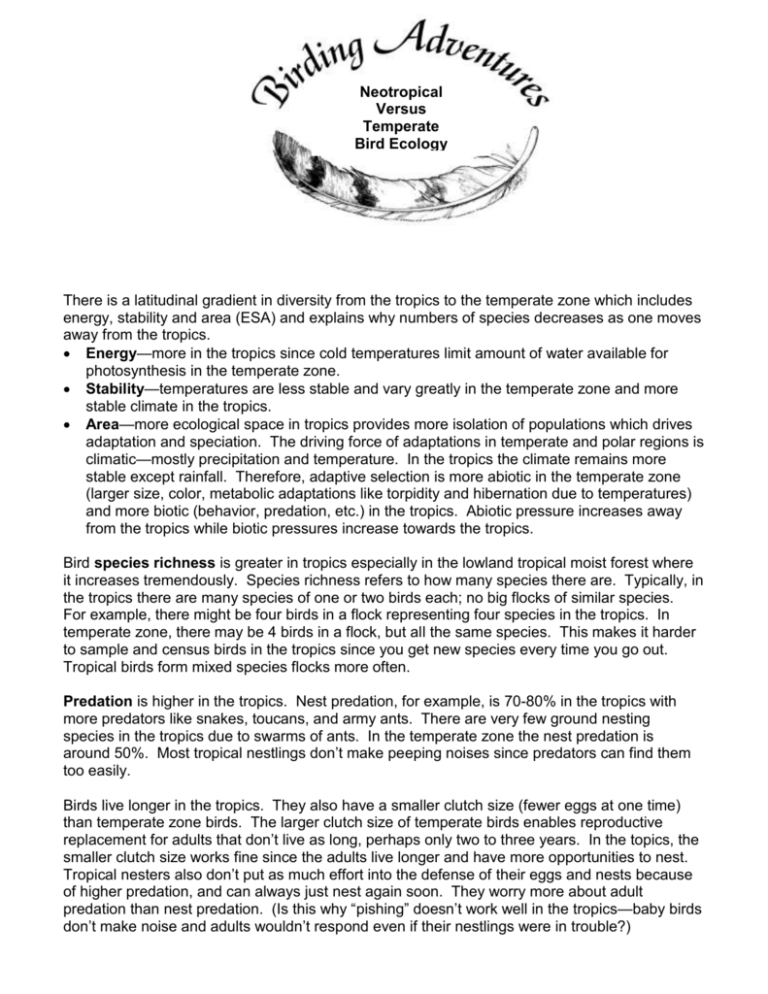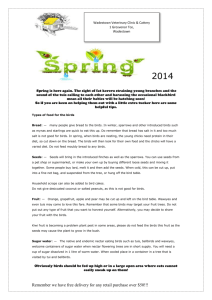Neoptropical Bird Ecology
advertisement

Neotropical Versus Temperate Bird Ecology There is a latitudinal gradient in diversity from the tropics to the temperate zone which includes energy, stability and area (ESA) and explains why numbers of species decreases as one moves away from the tropics. Energy—more in the tropics since cold temperatures limit amount of water available for photosynthesis in the temperate zone. Stability—temperatures are less stable and vary greatly in the temperate zone and more stable climate in the tropics. Area—more ecological space in tropics provides more isolation of populations which drives adaptation and speciation. The driving force of adaptations in temperate and polar regions is climatic—mostly precipitation and temperature. In the tropics the climate remains more stable except rainfall. Therefore, adaptive selection is more abiotic in the temperate zone (larger size, color, metabolic adaptations like torpidity and hibernation due to temperatures) and more biotic (behavior, predation, etc.) in the tropics. Abiotic pressure increases away from the tropics while biotic pressures increase towards the tropics. Bird species richness is greater in tropics especially in the lowland tropical moist forest where it increases tremendously. Species richness refers to how many species there are. Typically, in the tropics there are many species of one or two birds each; no big flocks of similar species. For example, there might be four birds in a flock representing four species in the tropics. In temperate zone, there may be 4 birds in a flock, but all the same species. This makes it harder to sample and census birds in the tropics since you get new species every time you go out. Tropical birds form mixed species flocks more often. Predation is higher in the tropics. Nest predation, for example, is 70-80% in the tropics with more predators like snakes, toucans, and army ants. There are very few ground nesting species in the tropics due to swarms of ants. In the temperate zone the nest predation is around 50%. Most tropical nestlings don’t make peeping noises since predators can find them too easily. Birds live longer in the tropics. They also have a smaller clutch size (fewer eggs at one time) than temperate zone birds. The larger clutch size of temperate birds enables reproductive replacement for adults that don’t live as long, perhaps only two to three years. In the topics, the smaller clutch size works fine since the adults live longer and have more opportunities to nest. Tropical nesters also don’t put as much effort into the defense of their eggs and nests because of higher predation, and can always just nest again soon. They worry more about adult predation than nest predation. (Is this why “pishing” doesn’t work well in the tropics—baby birds don’t make noise and adults wouldn’t respond even if their nestlings were in trouble?) Diversity of vegetation—size of the trees in the tropics is about the same as in the temperate zone. Most trees are animal pollinated in the tropics i.e., have more flowers to be pollinated by insects, bats, and birds. The tropics also have more structural diversity including more branch complexity, vines and lianas. Therefore, there are more opportunities for specialization and more potential resources in the tropics. This is called more “bird space”. And in spite of one’s first impression of the “jungle” neotropical forests are as different from one another as northern temperate forests. Guilds are ecological functions of birds. They can be thought of as “departments”—antfollowers, dead leaf-foragers, large arthropod consumers, large fruit consumers, highly frugivorous or omnivorous, obligate frugivores, bat predators etc. There are more frugivorous (fruit-eating) birds in the tropics than in the temperate zone. The advantage of eating fruit is that birds need to spend less time searching for it. Many fruit-eating birds are very colorful since they are often large birds (fruit has more nutrition) and the can just sit and eat fruit, not be worried about predators. Often frugivorous males and females are sexually dimorphic (different plumage) as in the manakins. Female manakins can feed their young by themselves since they are fruit eaters and there is an abundance of fruit. They don’t need the males. Therefore, male manakins can form leks where they compete with each other for females—sexual selection by females. There is not as much intraspecific competition among fruit –eating birds. With less competition there is less time spent finding and defending food and more time spent courting females as seen in the manakins. Whereas, insectivorous birds such as warblers and flycatchers are usually monogamous since it takes both to find food and feed young. Fruit eating versus insect eating—Insect eaters are more diversified than seed eaters (finches). Fruit eaters are more standard in morphology and often more different in color (tanagers). Flycatchers (insect eaters) are more diversified (beaks) because there is more competition for a limited resource. There are many more insect eating species than fruit eating species. Fruit—evolved to be eaten to disperse the seeds. A plant doesn’t want its own seeds to just drop below and try to grow—too much competition. Fruit eating animals carry the seed away from the parent tree so the seed has a chance to survive. Some seeds need abrasion of an animal’s digestive system to germinate. Trees and other plants rely on animals around to disperse seeds and scarify the outer coatings for germination. Fruit goes through color phases to attract birds. That makes it easy to find and to eat. In the tropics, fruit is available all year. Fruits are competing for birds and are under selection pressure to be appealing to birds. Also, since there is no peak of fruit production during the year, fruit eaters tend to nest anytime, but may be more controlled by availability of insects, which they feed to their nestlings. Fruit eaters tend to feed more in flocks in order to find patchy resource. Frugivorous birds (quetzal, bellbirds) tend to migrate altitudinally in order to follow fruiting trees, not latitudinally like insect eaters (warblers.) Because of the diversification and specialization of birds in the tropics, a change of tropical landscape affects more species than in a temperate landscape. A patch of rainforest destroyed in Costa Rica affects more species than the loss of a forest in Wisconsin since the temperate forest has less diversity and fewer species. It has more individual birds of one species, but not the diversity. Sex education time—there is more sperm competition selection in temperate birds since they breed all at one time for a short period of time. They have larger testicles than tropical birds that can breed all year long. Males in the temperate zone must compete during a short summer and need to get in the last sperm to fertilize the egg. Therefore, there are more extramarital matings in temperate zone birds. Tropical birds have larger territories than temperate birds. Food resources are spread thinner in tropical forests than in temperate forests. Both males and females in the tropics defend territories. Therefore, more of them tend to be truly monogamous while temperate zone birds often are not truly monogamous—they cheat. Temperate birds all mate and nest at the same time, so finding another mate to cheat with is easier—more available. In the tropics, females are receptive all year long; no need to cheat on her. Birding Adventures, Inc. Georgann Schmalz Ornithologist www.birdingadventuresinc.com georgannschmalz@windstream.net








